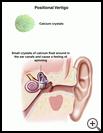
Positional Vertigo
________________________________________________________________________
KEY POINTS
- Positional vertigo is an inner ear problem that causes brief but sometimes severe feelings of spinning.
- Positional vertigo may go away without treatment. You may need to take medicine or learn repositioning techniques for mild vertigo.
- Do not try to drive or operate tools or machinery if you suddenly have feelings of spinning.
________________________________________________________________________
What is positional vertigo?
Positional vertigo is an inner ear problem. It causes brief but sometimes severe feelings of spinning when you tilt your head back, look up or down, or roll over in bed. This spinning is also called dizziness or vertigo. There are other names for the condition such as benign positional vertigo, positioning vertigo, and benign paroxysmal positional vertigo.
What is the cause?
In the inner part of your ear are 3 fluid-filled tubes called semicircular canals. When you move your body or head, the fluid in these canals tells your brain what your position is. That helps you keep your balance as you change position.
Other areas in your ear tell your brain when you move your head (side to side, right or left, up or down) and what your head’s position is in relation to the ground (or gravity). Small crystals of calcium in these areas may break loose and get into the fluid in your semicircular canals. The crystals float around in the canals and send the wrong messages to your brain, which cause the feeling of spinning.
People over age 50 may have this condition because the calcium crystals break free more easily as people age. More likely causes for people under age 50 include:
- Head injury
- Ear infections
- Ménière's disease, which is a disease of the inner ear
What are the symptoms?
Symptoms may include:
- A sudden feeling that you are spinning or that the room is spinning
- Trouble keeping your balance
- Blurred vision with the spinning
- Nausea or vomiting for several minutes or even hours after the vertigo
How is it diagnosed?
Your healthcare provider will ask about your symptoms and medical history and examine you. Tests may include:
- An ear exam
- A hearing test
- A position test, in which you lie back and move your head in certain directions. If you have positional vertigo, these movements will cause feelings of spinning and fast, jerky movements of your eyes. Your provider may have you wear magnifying goggles to help him see the eye movements. This test may be done with an ENG (electronystagmogram), which uses small wires pasted or taped to your head to measure and record eye movements.
You may have tests or scans to check for other possible causes of your symptoms, such as a stroke or brain tumor.
How is it treated?
Positional vertigo may go away within several weeks, even without treatment.
You may need to take medicine for mild symptoms to reduce the vertigo and any nausea you may be having. The medicine may make you sleepy, so talk to your healthcare provider about any medicine you are taking.
If your vertigo lasts for many days or weeks, you may need to learn repositioning techniques. Repositioning involves moving your head into 4 specific positions. You hold each position for about 30 seconds. Doing this works with gravity to move the crystals into an area of the inner ear that won't cause any problems. Your healthcare provider may refer you to a physical therapist to learn and practice these techniques.
If you have severe vertigo that has not gone away after a few weeks, or if it comes back after treatment, you may need surgery. Two types of surgery may be used to stop the vertigo.
- Part of your ear may be surgically plugged to keep the crystals from moving.
- The nerve that connects the brain with the semicircular canal may be cut to keep your brain from sensing the movement of the crystals.
How can I take care of myself?
Follow the full course of treatment prescribed by your healthcare provider. In addition:
- If your vertigo does not allow you to continue your usual routine safely, you should rest at home.
- Do not try to drive, operate tools or machinery, or do other tasks, even cooking, that could endanger yourself or others if you suddenly have feelings of spinning.
Ask your provider:
- How and when you will get your test results
- How long it will take to recover
- If there are activities you should avoid and when you can return to your normal activities
- How to take care of yourself at home
- What symptoms or problems you should watch for and what to do if you have them
Make sure you know when you should come back for a checkup. Keep all appointments for provider visits or tests.

